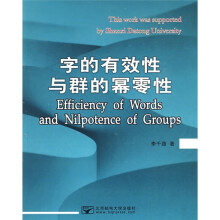Chapter 1 Preface
Chapter 2 Fundamental Concept Ⅰ: Free Groups
2.1 Free Groups in a Class
2.2 Words
2.3 (Absolutely) Free Groups
Chapter 3 Words in the Free Group F2
3.1 Commutator Remainders
3.2 Efficient Words
3.3 Homomorphie Images of Words
3.4 Homomorphie Invariant
3.5 Homomorphie Properties
3.6 Efficiency of Words
Chapter 4 General Words
4.1 Notions and Notations
4.2 Standard Forms of Words
4.3 Uniqueness of Standard Forms
4.4 Criterion of Efficiency
Chapter 5 Properties of the Standard Exponents of Words
5.1 Words of the Form ω(x1m1,…,xnmn)
5.2 Words of the Form ω1l1…ωlss
5.3 Words to and to ωσ
Chapter 6 Fundamental Concept ll:Nilpotent Groups
6.1 Nilpotenee of Groups
6.2 Preliminary Properties of Nilpotent Groups
6.3 The Most Important Subclasses of Nilpotent Groups
6.3.1 Finite Nilpotent Groups
6.3.2 Finitely Generated Nilpotent Groups
6.3.3 Torsion-free Nilpotent Group
6.4 Generalizations of Nilpotence
6.4.1 Local Nilpotence
6.4.2 The Normalizer C0ndition
Chapter 7 Collapsing Groups
7.1 Engel Identities
7.2 Collapsing Conditions
7.3 Collapsing Laws for Almost Nilpotence
7.4 Residually Finite Groups
Chapter 8 Groups Satisfying Positive Words
8.1 Some Properties
8.2 Nilpotenee
8.3 SB-groups
Chapter 9 Milnor Groups and Groups Satisfying Efficient Words
9.1 Groups Satisfying Efficient Words
9.1.1 Efficient Conditions
9.1.2 Efficiency and Nilpotenee
9.2 Milnor Groups
9.3 Finite f-Milnor Groups
9.3.1 Finite Soluble f-Milnor Groups
9.3.2 Finite Nilpotent Groups in My
9.3.3 Finite f-Milnor Groups
Chapter 10 Polycyclic Groups
10.1 Properties of Polyeyelie Groups
10.2 Polycyelic Conditions for Nilpotence
10.3 Polycyelic Groups in Varieties
10.4 Nilpotent Polycyclic Groups
Chapter 11 Varieties of Groups
11.1 Words and Varieties
11.2 Nilpotent Conditions
11.3 Varieties with Finite Basis
11.4 Variety A2
Chapter 12 Metabelian Suhvarieties of Groups
12.1 Variety ApA
12.2 Variety ApA
12.2.1 Some Lemmas
12.2.2 Milnor Groups and Nilpotence
12.3 Variety AA
Chapter 13 Finitely Generated f-Milnor Groups
13.1 Weak Milnor Classes
13.2 Structure off-Milnor Groups
13.3 Strong Milnor Classes
Chapter 14 Criteria for Almost Nilpotence
14.1 Laws for CpC
14.2 Varieties Being Almost Nilpotent
14.3 Some Preliminary Results of Groups
14.3.1 Commutator Groups
14.3.2 Isolators of Subgroups
14.4 Torsion-by-Nilpotent Groups
14.5 Example
Bibliography

 缺书网
缺书网 扫码进群
扫码进群






